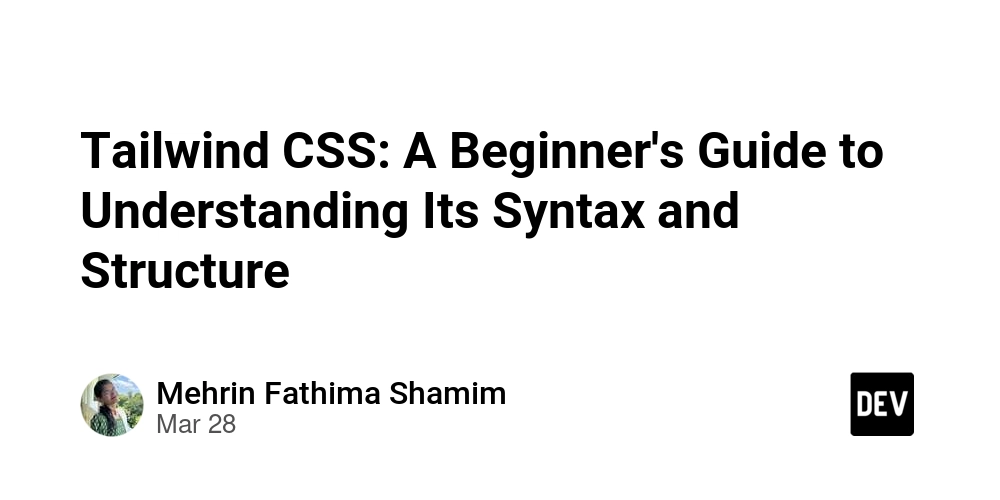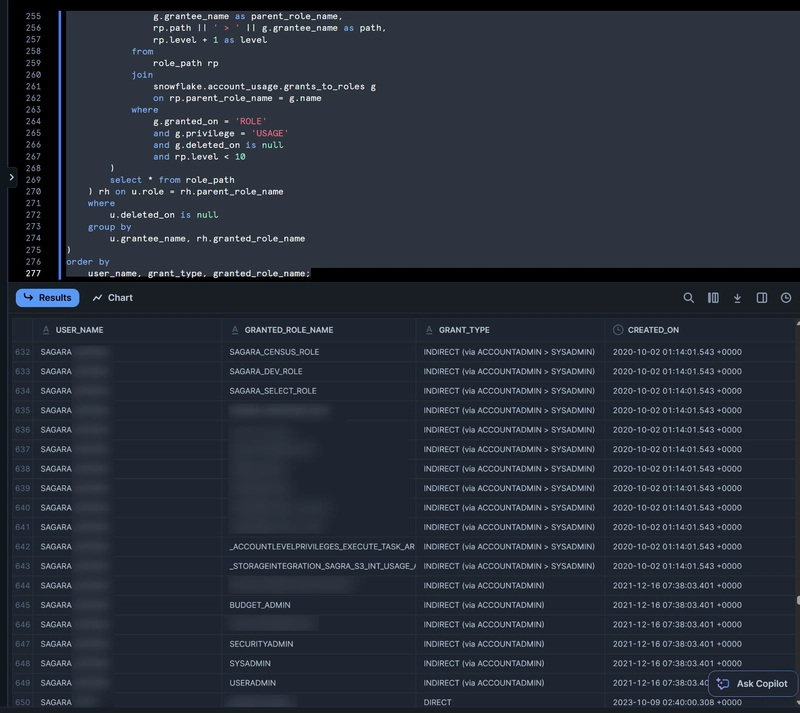Tailwind CSS: A Beginner's Guide to Understanding Its Syntax and Structure
Introduction: How I Discovered Tailwind CSS I've always been more comfortable working with backend development—APIs, databases, and server-side logic. Styling, on the other hand, always felt like an entirely different world. Writing raw CSS meant managing stylesheets, worrying about specificity, and dealing with unpredictable layouts. Even CSS frameworks like Bootstrap felt too rigid for me. Then I discovered Tailwind CSS, and I was like—"OK, this is something I can work with!" It had a common syntax and a one-for-all structure that made sense. Instead of switching between multiple files, naming classes, and dealing with stylesheet bloat, I could just use predefined utility classes directly in my HTML. It felt structured, predictable, and—most importantly—it didn't slow me down. This post is for anyone like me who struggled to get into frontend styling or just wants a simple way to understand how Tailwind CSS works. My goal is to break it down in a way that makes sense, so you can start using it without feeling lost. The Challenges of Traditional CSS Before diving into Tailwind, let's acknowledge why CSS can be so challenging, especially for those of us who think in terms of functions and data structures: Mental Context Switching: Moving between HTML files and CSS files requires constant context switching. Naming Conventions: Coming up with meaningful, non-conflicting class names becomes increasingly difficult as projects grow. Specificity Wars: Determining which CSS rules take precedence often feels like solving a complex puzzle. Stylesheet Bloat: CSS files tend to grow over time, making it difficult to know what's still being used and what can be safely removed. For example, creating a simple button with traditional CSS means writing something like: Click Me /* CSS file */ .primary-button { background-color: #3b82f6; color: white; padding: 0.5rem 1rem; border-radius: 0.25rem; font-weight: 700; } This might seem simple at first, but as your application grows, you'll find yourself constantly jumping between files, dealing with naming conflicts, and struggling with specificity issues. What You'll Get from This Guide A straightforward approach to understanding Tailwind CSS, making it accessible even if you're new to styling. Insights into how Tailwind structures styles, highlighting how it feels more like writing structured code than designing. The essential knowledge you need to start using Tailwind effectively. A practical breakdown of how to style elements in Tailwind without overcomplicating things. Real-world comparisons: How you might traditionally write CSS versus achieving the same results with Tailwind. Why Tailwind is Appreciated by Developers In my journey, styling often felt like an additional chore. Writing raw CSS involved managing multiple files, and even frameworks like Bootstrap seemed rigid and bloated. Discovering Tailwind CSS was a turning point. It's not just for backend developers seeking an easier way to style; even experienced frontend developers prefer it over traditional CSS. Here's why: Consistency and Speed: Tailwind speeds up development and maintains consistent styles across projects. Simplified Styling: It eliminates the hassle of writing and managing separate CSS files. Unified Design Systems: Teams can maintain a design system without needing separate stylesheets. Tailwind isn't a shortcut—it's a different way of thinking about styling that benefits both new learners and seasoned developers. How Tailwind Works: Structure & Syntax At its core, Tailwind CSS is a utility-first CSS framework. Instead of writing separate CSS rules, you use small utility classes directly in your HTML or JSX to style elements. Basic Tailwind Syntax Consider this example: Click Me Each class represents a single styling rule: bg-blue-500 → Background color (blue) text-white → Text color (white) font-bold → Font weight (bold) py-2 → Vertical padding px-4 → Horizontal padding rounded → Rounded corners This approach removes the need for separate CSS files or manually creating unique class names. Tailwind's Core Concepts To truly understand Tailwind, here are the main building blocks you need to know: a) Utility Classes (Predefined Styles) Instead of writing: .button { background-color: #3b82f6; color: white; padding: 10px 20px; border-radius: 5px; } You directly use Tailwind classes: Click Me b) Responsive Design (Without Writing Media Queries) Instead of: @media (min-width: 768px) { .text { font-size: 24px; } } You just use: Responsive Text Prefixes like sm:, md:, lg: apply styles based on screen size. c) Flexbox and Grid (Easier Layouts) Instead of: .container { display: flex; justify-content: center; align-items: center; height: 100vh; } You j

Introduction: How I Discovered Tailwind CSS
I've always been more comfortable working with backend development—APIs, databases, and server-side logic. Styling, on the other hand, always felt like an entirely different world. Writing raw CSS meant managing stylesheets, worrying about specificity, and dealing with unpredictable layouts. Even CSS frameworks like Bootstrap felt too rigid for me.
Then I discovered Tailwind CSS, and I was like—"OK, this is something I can work with!" It had a common syntax and a one-for-all structure that made sense. Instead of switching between multiple files, naming classes, and dealing with stylesheet bloat, I could just use predefined utility classes directly in my HTML. It felt structured, predictable, and—most importantly—it didn't slow me down.
This post is for anyone like me who struggled to get into frontend styling or just wants a simple way to understand how Tailwind CSS works. My goal is to break it down in a way that makes sense, so you can start using it without feeling lost.
The Challenges of Traditional CSS
Before diving into Tailwind, let's acknowledge why CSS can be so challenging, especially for those of us who think in terms of functions and data structures:
Mental Context Switching: Moving between HTML files and CSS files requires constant context switching.
Naming Conventions: Coming up with meaningful, non-conflicting class names becomes increasingly difficult as projects grow.
Specificity Wars: Determining which CSS rules take precedence often feels like solving a complex puzzle.
Stylesheet Bloat: CSS files tend to grow over time, making it difficult to know what's still being used and what can be safely removed.
For example, creating a simple button with traditional CSS means writing something like:
class="primary-button">Click Me
/* CSS file */
.primary-button {
background-color: #3b82f6;
color: white;
padding: 0.5rem 1rem;
border-radius: 0.25rem;
font-weight: 700;
}
This might seem simple at first, but as your application grows, you'll find yourself constantly jumping between files, dealing with naming conflicts, and struggling with specificity issues.
What You'll Get from This Guide
- A straightforward approach to understanding Tailwind CSS, making it accessible even if you're new to styling.
- Insights into how Tailwind structures styles, highlighting how it feels more like writing structured code than designing.
- The essential knowledge you need to start using Tailwind effectively.
- A practical breakdown of how to style elements in Tailwind without overcomplicating things.
- Real-world comparisons: How you might traditionally write CSS versus achieving the same results with Tailwind.
Why Tailwind is Appreciated by Developers
In my journey, styling often felt like an additional chore. Writing raw CSS involved managing multiple files, and even frameworks like Bootstrap seemed rigid and bloated. Discovering Tailwind CSS was a turning point. It's not just for backend developers seeking an easier way to style; even experienced frontend developers prefer it over traditional CSS.
Here's why:
- Consistency and Speed: Tailwind speeds up development and maintains consistent styles across projects.
- Simplified Styling: It eliminates the hassle of writing and managing separate CSS files.
- Unified Design Systems: Teams can maintain a design system without needing separate stylesheets.
Tailwind isn't a shortcut—it's a different way of thinking about styling that benefits both new learners and seasoned developers.
How Tailwind Works: Structure & Syntax
At its core, Tailwind CSS is a utility-first CSS framework. Instead of writing separate CSS rules, you use small utility classes directly in your HTML or JSX to style elements.
Basic Tailwind Syntax
Consider this example:
class="bg-blue-500 text-white font-bold py-2 px-4 rounded">
Click Me
Each class represents a single styling rule:
-
bg-blue-500→ Background color (blue) -
text-white→ Text color (white) -
font-bold→ Font weight (bold) -
py-2→ Vertical padding -
px-4→ Horizontal padding -
rounded→ Rounded corners
This approach removes the need for separate CSS files or manually creating unique class names.
Tailwind's Core Concepts
To truly understand Tailwind, here are the main building blocks you need to know:
a) Utility Classes (Predefined Styles)
Instead of writing:
.button {
background-color: #3b82f6;
color: white;
padding: 10px 20px;
border-radius: 5px;
}
You directly use Tailwind classes:
class="bg-blue-500 text-white px-4 py-2 rounded">
Click Me
b) Responsive Design (Without Writing Media Queries)
Instead of:
@media (min-width: 768px) {
.text {
font-size: 24px;
}
}
You just use:
class="text-sm md:text-lg lg:text-2xl">Responsive Text
Prefixes like sm:, md:, lg: apply styles based on screen size.
c) Flexbox and Grid (Easier Layouts)
Instead of:
.container {
display: flex;
justify-content: center;
align-items: center;
height: 100vh;
}
You just use:
class="flex items-center justify-center h-screen">
Centered Content
Setting Up Tailwind in Your Project
Getting started with Tailwind CSS is straightforward. I am using Vite with React, and here is how your project structure might look:
REACT-TAILWINDCSS-PROJECT
├── node_modules
├── public
├── src
│ ├── assets
│ ├── App.jsx
│ ├── index.css
│ ├── main.jsx
├── .gitignore
├── eslint.config.js
├── index.html
├── package-lock.json
├── package.json
├── README.md
├── vite.config.js
Basic Setup
The setup involves these steps:
1. Create a New Vite Project
npm create vite@latest my-project --template react
cd my-project
npm install
2. Install Tailwind CSS
npm install tailwindcss @tailwindcss/vite
3. Configure Vite
Edit the vite.config.js file to include Tailwind:
import { defineConfig } from 'vite';
import react from '@vitejs/plugin-react-swc';
import tailwindcss from '@tailwindcss/vite';
export default defineConfig({
plugins: [
react(),
tailwindcss()
],
});
4. Configure Tailwind
It's fine if the tailwind.config.js file is not created automatically; you can manually create it with the following content:
module.exports = {
content: ["./index.html", "./src/**/*.{js,ts,jsx,tsx}"],
theme: {
extend: {},
},
plugins: [],
}
5. Add Tailwind to Your CSS
Replace the existing index.css file with the following:
@import "tailwindcss";
6. Link CSS in HTML
Ensure your index.html includes the following line in the section:
href="/src/index.css" rel="stylesheet">
7. Start the Development Server
npm run dev
For more details, you can refer to the official Tailwind CSS Vite Installation Guide.
Practical Patterns: Solving Common Styling Challenges
Creating Reusable Components
One common concern is that Tailwind might lead to repetitive class names across your application. Here are two solutions:
- Extract a Component (React/Vue/Angular):
const Button = ({ text, color }) => {
return (
<button className={`bg-${color}-500 text-white px-4 py-2 rounded`}>
{text}
button>
);
};
export default Button;
- Use the @apply directive in your CSS:
@layer components {
.btn-primary {
@apply bg-blue-500 text-white px-4 py-2 rounded hover:bg-blue-700;
}
}
Then use it in your HTML:
class="btn-primary">Click Me
Building a Responsive Card Component
Let's create a card component that adapts to different screen sizes:
class="bg-white rounded-lg shadow-md p-4 md:p-6 lg:p-8">
class="w-full h-32 md:h-48 object-cover rounded-t-lg" src="image.jpg" alt="Card image">
class="mt-4">
class="text-lg md:text-xl font-semibold">Card Title
class="text-gray-600 mt-2">This is a responsive card that looks good on all devices.
class="mt-4 bg-blue-500 text-white px-4 py-2 rounded hover:bg-blue-600">
Read More











































































